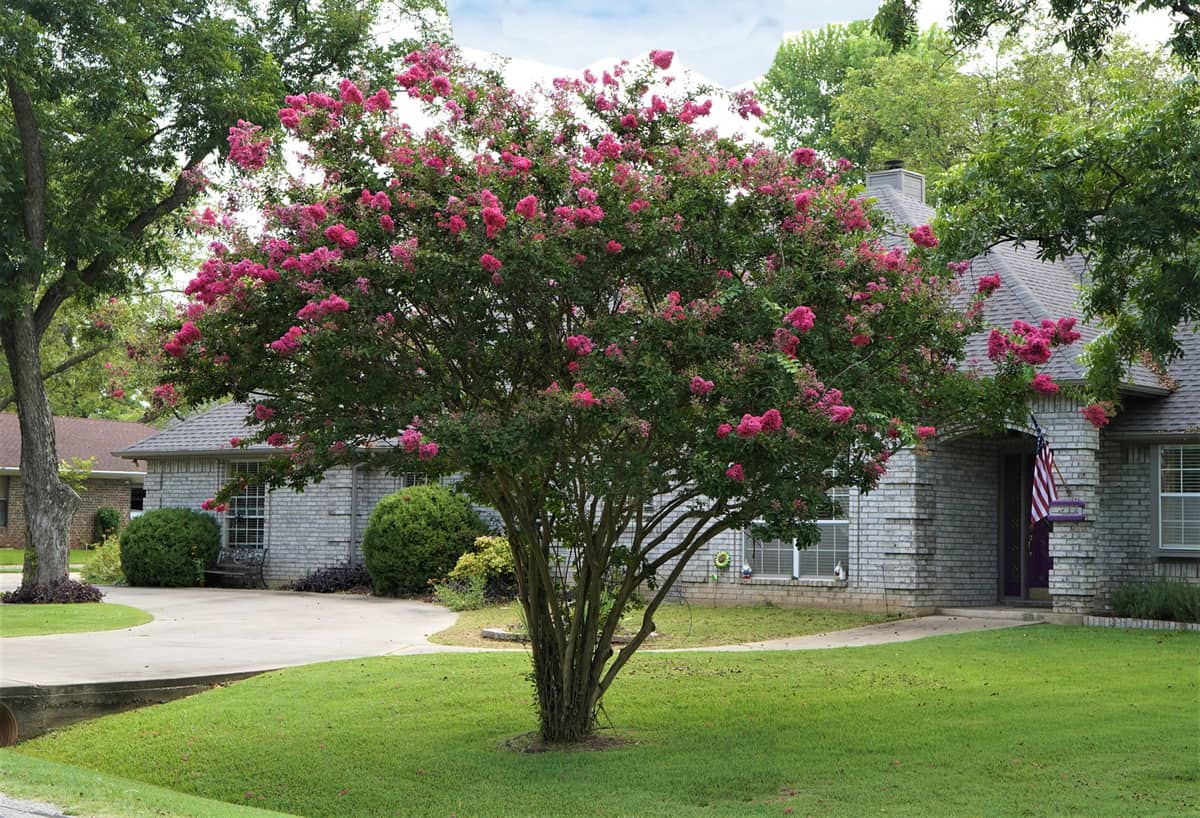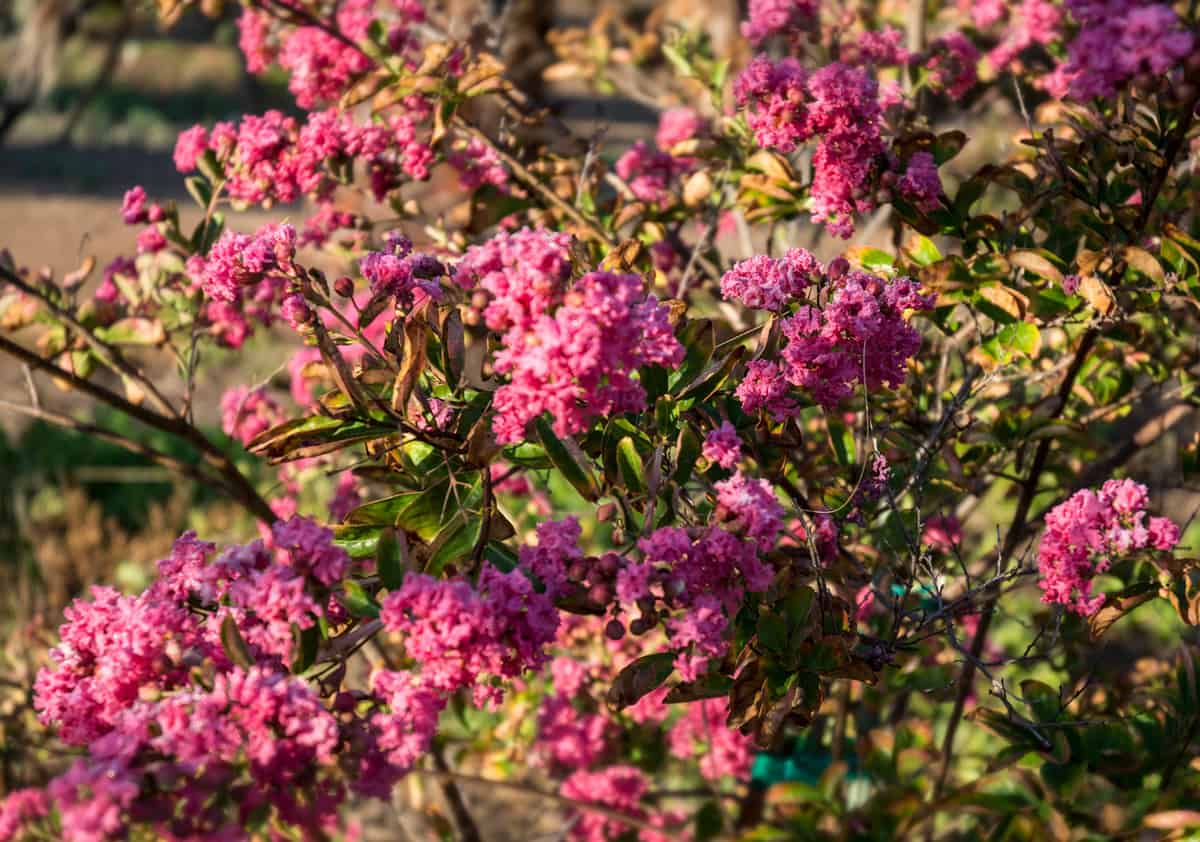Getting to know all of the plants in your garden sometimes feels impossible. Have you started to notice your crepe myrtles leaves turning yellow in the summer and don't know what could be wrong? Well, we've done plenty of research and have all of the answers waiting here for you. Let's dive right in.
The two main reasons a crepe myrtles leaves turn yellow in the summer are poor soil drainage and lack of water. Considering that the summer months can be tough on your plants, not giving a crepe myrtle plenty of hydration can lead to serious problems.
Furthermore, crepe myrtles leaves could also become yellow if your plant doesn't get enough sun exposure, so make sure it's somewhere with good daily light.
As we begin, we will cover all things crepe myrtles and discuss how to keep your plant's foliage from turning yellow in the summertime. Whether you're new to this species or need help with a mature plant, we're here to offer some tips and tricks. With that said, let's explore this topic!

What Causes Yellow Leaves On A Crepe Myrtle?

Although various factors can impact the color and quality of a crepe myrtles leaves, soil and hydration tend to be the primary culprits.
As we said, a lack of drainage and water can lead to yellowing leaves during the summer (or anytime throughout the year), so it's important to ensure your myrtle is getting everything it needs.
Furthermore, a crepe myrtle needs about six hours of sun per day. So if your plant gets closer to three or four, you could notice yellowing foliage.
Again, this shouldn't be anything you can't fix, so inspect your plant's soil ASAP if you start to see yellow leaves.
Why Are My Crepe Myrtles Leaves Turning Yellow In July?
If your crepe myrtle starts yellowing in July, this could mean a few things. Most commonly, drought or a lack of moisture will cause crepe myrtles leaves to yellow and prematurely fall.
Your plant might also have a bacterial disease or fungus, which will also start as yellowing foliage. This is also known as 'leaf scorch' and tends to affect crepe myrtles during the summertime.
Luckily, you can typically fix this problem with a bit of water, new soil, and TLC, so all hope isn't lost yet.
Why Is My Crepe Myrtle Losing Leaves In The Summer?
Generally, falling crepe myrtle leaves during summer mean your plant has a fungal disease. Like we said above, leaf scorch is common in this species and typically hits during the summer, so that could be to blame.
You may also notice dark spots on the leaves of your crepe myrtle (Cercospora), which indicates your plant is sick.
To fix this, make sure your myrtle gets six hours of sunlight daily, water it 1-2 times a week, and make sure to check its soil for signs of bacteria, fungus, or disease.
If this is pretty serious, you may need to have a specialist inspect your crepe myrtle, so don't hesitate to reach out to someone if you have further questions.
What Month Do Crepe Myrtles Lose Their Leaves?
Normally, a crepe myrtle will lose its leaves from late fall into early winter. Considering this species is deciduous, you can expect a crepe myrtle to lose the majority of its foliage by around late November.
Again, this is completely normal, so if the weather has cooled down a bit and it's late summer/early fall, a little foliage loss isn't something to worry about.
The only time you should worry is if all of the leaves on your myrtle have discolored and more than a third of them have fallen during summertime.
Can You Cut Back A Crepe Myrtle In The Summer?

Although you can, we don't recommend pruning crepe myrtle in the summer. Considering this plant can bloom up to 120 days, pruning your myrtle before the late fall can affect its natural cycle.
Furthermore, crepe myrtle doesn't love a lot of pruning, as it can cause their leaves to discolor and fall off, so try to keep it minimal.
Instead, we recommend cutting back a crepe myrtle closer to mid-October, as it won't be in bloom and is ready to begin dormancy.
What Happens If You Don't Cut Back Crepe Myrtle?
If you don't prune a crepe myrtle, expect a leggy-looking tree. Not cutting back a crepe myrtle can also affect its growth, so regular pruning is essential if you want to see yours fill out and get bigger.
On top of that, cutting back crepe myrtle can encourage more blooms, so this is great for adding some color to your garden.
That said, you shouldn't need to cut your plant back more than a few inches, so this doesn't need to be dramatic.
Can You Overwater A Crepe Myrtle?
Yes, it is possible to overwater a crepe myrtle. Especially during their spring-summer blooming period, overwatering a crepe myrtle can affect its flower production and overall growth.
Saturated soil tends to cause legginess in this plant species, so try to keep your watering moderate. Furthermore, crepe myrtle's leaves will begin to yellow if it has too much water, so that's an easy indicator to watch out for.
Is Crepe Myrtle Drought Tolerant?
Considering how much they love the sun, crepe myrtles are drought tolerant. Typically growing in USDA zones 7-10, the crepe myrtle is extremely heat-tolerant and quite drought-tolerant once established.
If the conditions are right, a crepe myrtle can also grow in USDA zone six, so this plant is pretty hardy across the board.
Again, that's not to say you shouldn't give your shrub/tree a good watering once or twice a week, but if you forget, it's not the end of the world.
Why Are The Leaves On My Crepe Myrtle Turning Brown?

If the leaves on your crepe myrtle start turning brown, this could be due to drought. Like we said above, this species is drought tolerant to a point, but that doesn't mean your plant won't show signs if it needs water.
Heat can also cause the leaves on a crepe myrtle to essentially "burn," so this could be environmental. Again, if it's super hot outside and your tree/shrub looks like it needs a drink, you should make sure to water it thoroughly.
How Often Should I Water My Crepe Myrtle In The Summer?
Ideally, you want to water a crepe myrtle 1-2 times a week during the summer. That said, a newly planted crepe myrtle needs up to five watering a week for its first month or so, so that's something to consider.
Weather and overall climate can affect how much water your plant will need. More watering will be best for your crepe myrtle if it's hot and dry outside. If it's a bit cooler and recently rained, one or two times a week will be sufficient.
You can also feel around the base of your myrtle before watering to ensure you aren't overdoing it, so that's our recommendation.
What Are The Signs Of A Dying Crepe Myrtle?
For those suspecting their crepe myrtle is dying, there are some signs to look out for. Typically, these include:
- Spotted leaves and sparse blooms.
- White, powdery residue on your plant.
- Mold and mildew develop on your crepe myrtle.
A dying crepe myrtle will also be extremely dry on its base and branches if it starts to die, which in that case, your tree/shrub might be on its last leg.
Can You Save A Dying Crepe Myrtle?

The best way to try and save a crepe myrtle is to prune off any dead or affected areas. Whether it's mold, mildew, or any strange-looking foliage, try to remove it from your plant.
You can also try to cut off the ends of your tree/shrub's branches, which will promote new, healthy growth. According to TreeNenewal, using a mixture of soap and water and then washing the trunk and limbs of your tree can help to save it.
As we said, crepe myrtles tend to show early signs of disease through their leaves, so if yellowing or browning begins to happen at off times, you want to pay close attention to that area.
To Wrap It Up
Whether you have a crepe myrtle in your garden or want one, it's essential to know how to care for it. From what we found, a crepe myrtle shouldn't be turning yellow in the summer, so this could mean your tree needs more water/better soil drainage.
Your tree or shrub could also need more sunlight, ideally close to six hours a day, so make sure to plant yours in a sunny location. Furthermore, crepe myrtle may start to lose its foliage toward the end of summer of its cooling down, so yellowing leaves are expected in that situation.
Regardless, make sure to water your crepe myrtle 1-2 times in the summer, and don't be afraid to cut your plant back toward the late fall-early winter.
Made it to the end? Check out these helpful related garden posts below!
Crepe Myrtle Bark Peeling And Splitting - What To Do?
